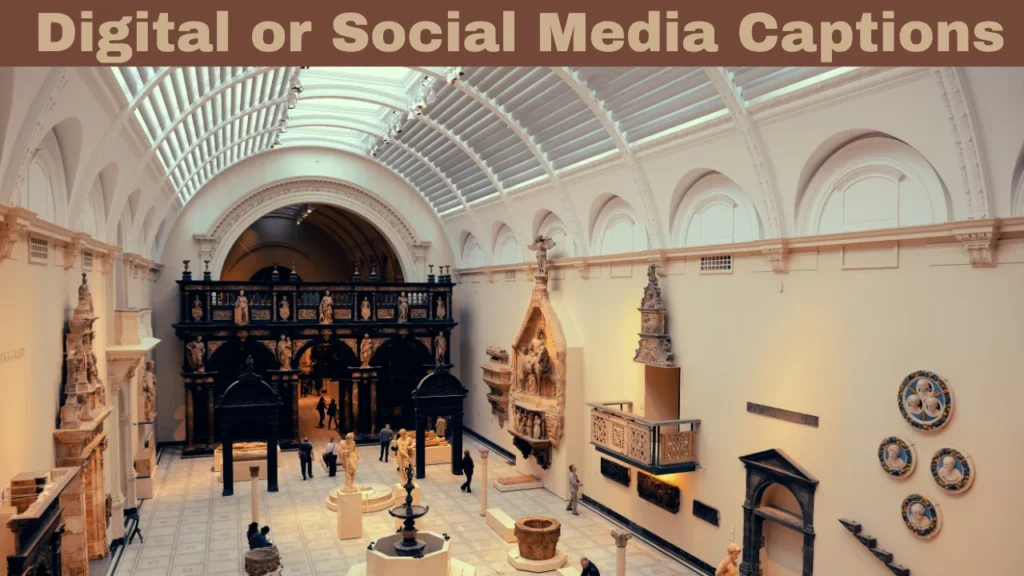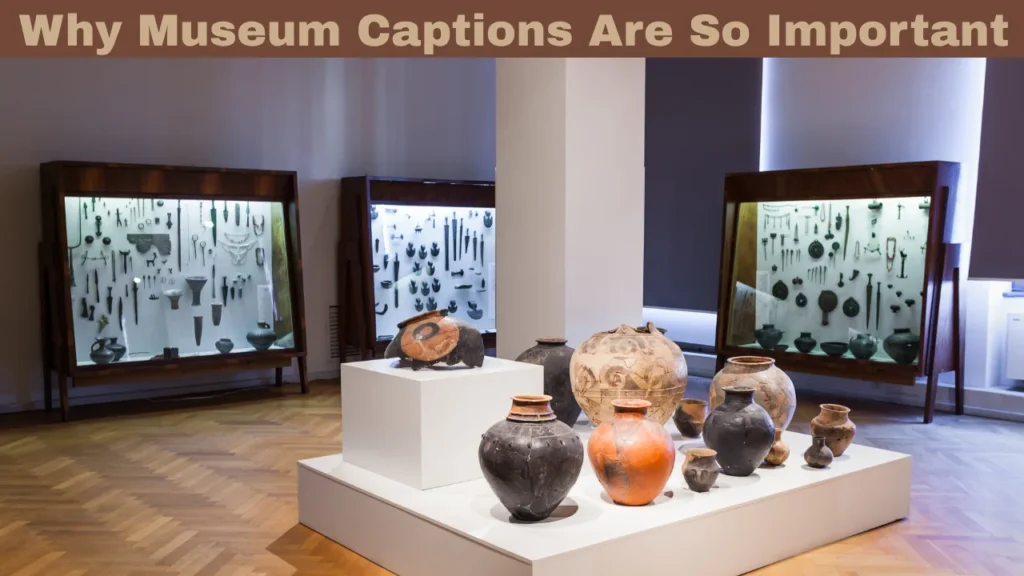300+ Best Top Caption About Museum

Have you ever walked through a museum and found yourself drawn to a short piece of text next to an object? That’s a caption about museum. While it may seem small, it plays a huge role in how we understand what we’re looking at. A good caption can take an ordinary object and turn it into a story. In this blog, we’ll explore what a museum caption is, why it’s important, and how you can create one that helps people connect with history, art, and science.
Also Read: 310+ Top Grief Quotes
Table of Contents
What Is a Caption About Museum?
A caption is a short explanation placed next to an exhibit or artifact. It helps visitors understand what they’re looking at. It might tell you the name of the object, when it was made, who made it, and why it matters.
The purpose of a museum caption is not just to share facts. It’s there to tell a story. It gives context to what would otherwise be just a beautiful painting, an old tool, or a piece of ancient pottery. These captions connect the past to the present and make learning more fun and meaningful.
Different Types of Captions About Museums
Captions can change depending on the kind of museum. Let’s look at a few examples:
Descriptive Captions
Art museums often use emotional or descriptive language. The caption may explain the artist’s background, technique, and what they were trying to say. Here are descriptive captions you can use or adapt for museum exhibits. These captions follow the descriptive style—short, factual, and informative—suitable for labeling objects clearly:
- Bronze Helmet, Ancient Greece, 6th century BC. Worn by soldiers during battle to protect the head and face.”
- “Oil on canvas, painted by Claude Monet, 1872. This artwork captures the sunrise over a French harbor.”
- “Mayan Pottery Bowl, Guatemala, 300 AD. Used for food storage in ceremonial settings.”
- “Iron Sword, Medieval Europe, 12th century. This weapon belonged to a knight during the Crusades.”
- “Egyptian Scarab Amulet, 1500 BC. Made of blue faience and used as a symbol of rebirth in burial rituals.”
- “Roman Coin, minted 44 BC. Features Julius Caesar and was used widely across the Roman Republic.”
- “Stone Axe Head, Neolithic Period, 4000 BC. Crafted by hand for chopping wood and preparing animal hides.”
- “Silk Robe, Qing Dynasty, 18th century China. Worn by high-ranking officials in the imperial court.”
- “Telescope, made by Galileo Galilei, 1609. Used to observe the moon and planets for early astronomy.”
- “Dinosaur Fossil, Tyrannosaurus rex, 65 million years old. Found in Montana and displayed in full scale.”
- “Terracotta Figurine, Indus Valley Civilization, 2000 BC. Believed to represent fertility or a goddess.”
Interpretive Captions
Here are interpretive captions that go beyond facts to explore meaning, symbolism, and context—perfect for creating deeper emotional or intellectual connections in a museum setting:
- “This mask wasn’t just worn for dance—it was believed to let spirits enter the human world during ceremonies.”
- “Monet’s use of soft light and blurred strokes invites viewers to feel the quiet peace of early morning.”
- “These beads were more than decoration—they showed a person’s place in society and tribe.”
- “This cracked pottery tells the story of daily meals and family gatherings from 2,000 years ago.”
- “More than a weapon, this sword symbolized honor and the code of the warrior class.”
- “Painted in the heat of revolution, this artwork reflects the chaos and hope of a changing nation.”
- “This flute’s high-pitched sound was once believed to connect the player to the gods of wind and rain.”
- “This tiny bronze figure may have been carried for protection—like a good luck charm for ancient travelers.”
- “These cave paintings offer a glimpse into the thoughts, fears, and triumphs of early human storytellers.”
- “The jagged edges of this shield suggest it saw battle—perhaps a fight that shaped a nation’s future.”
- “Even without words, this sculpture expresses sorrow, loss, and the deep emotions of war.”
Digital or Social Media Captions

Here are digital or social media captions tailored for museum-related content. These are ideal for platforms like Instagram, Facebook, or Twitter. They’re catchy, brief, and designed to engage your audience with hashtags, emojis, or questions.
- “Time travel doesn’t need a machine—just a museum ticket. 🕰️ #HistoryUnfolded”
- “Can you guess what this 2,000-year-old tool was used for? 🛠️ #ArtifactChallenge #MuseumFun”
- “She’s been smiling for 500 years… and still no one knows why. 🖼️ #MonaLisaMood #ArtMystery”
- “When fashion meets history 👗 This 18th-century gown still slays! #ThrowbackStyle #MuseumLooks”
- “You + dinosaurs = ROAR-some fun 🦖 Tag a friend who’d love this fossil! #PrehistoricVibes”
- “Ancient tools, modern inspiration 🔨 Which invention do you think came next? #ThenVsNow”
- “Not your average selfie backdrop. 📸 Where history and hashtags meet. #MuseumSelfie”
- “Did you know this tiny coin once ruled an empire? 💰 #MuseumTrivia #AncientEconomy”
- “Touching history… with your eyes 👀 Only! #LookDontTouch #MuseumRules”
Audio-Visual Captions
Here are audio-visual captions ideal for use in museum multimedia presentations, virtual tours, touchscreen kiosks, or video displays. These captions guide users through what they are hearing or seeing, and they’re designed to be clear, concise, and educational.
- “Listen to the sound of this ancient flute—played during rituals over 3,000 years ago.”
- “Watch how this medieval armor was worn piece by piece before battle.”
- “Hear the roar of a T. rex, digitally recreated based on fossil evidence.”
- “This animation shows how the pyramids of Egypt were built using ramps and pulleys.”
- “Tap to hear what messages were sent using Morse code during World War II.”
- “See how this painting changes under ultraviolet light, revealing hidden brushstrokes.”
- “This 3D scan lets you rotate the artifact to view carvings not visible in the case.”
- “Watch this ancient clock mechanism in motion—it still tells time accurately.”
- “Hear the story of the artist who painted this during a time of political unrest.”
- “This video shows how dinosaurs may have moved based on bone structure and muscle modeling.”
- “Click here to hear the sounds of a 19th-century printing press in action.”
What Makes a Good Caption?
Not all captions are good. A weak caption may confuse readers or bore them. A good caption is short, clear, and full of meaning. Here are the key parts of a quality caption:
| Feature | Description |
|---|---|
| Title | The name of the item or artifact |
| Creator or Culture | Who made it or which culture it belongs to |
| Date or Era | When the item was made or used |
| Function | What it was used for or how it worked |
| Significance | Why it matters or how it fits into history or science |
The caption should not be more than 2–3 short sentences. People don’t read long paragraphs while standing in a gallery.
Also Read: 180+ Attitude Caption for Instagram
Why Museum Captions Are So Important

Museum captions are incredibly important because they give meaning to what visitors see. Without captions, many objects in a museum would simply look like old tools, broken statues, or faded paintings. A good caption explains what the object is, who made it, when it was used, and why it matters. It turns silent items into powerful stories that connect the past to the present. Captions also help people of all ages and backgrounds understand complex ideas in simple ways. Whether it’s a child visiting a museum for the first time or a history lover exploring an exhibit, the caption acts like a guide. It sparks curiosity, encourages learning, and adds emotional or cultural value to the experience. This is why every caption about museum is more than just words—it’s a bridge between the viewer and history.
Using Captions in School Projects or Blogs
If you’re a student or blogger writing about museums, a good caption about museum can improve your project or article. It adds clarity and professionalism to your work.
Let’s say you visited a war memorial museum. You took photos and now want to share them in a blog. Don’t just post the photo. Add a caption like:
“This helmet was worn by a soldier in World War I. It protected him during trench battles in France.”
That tells a story. It helps your readers understand the photo and makes your content stand out.
Common Caption Mistakes to Avoid
Here are some common problems that ruin a caption:
- Too much detail – Don’t write a mini essay. Keep it short and focused.
- Using big words – If a word is hard to say or spell, pick a simpler one.
- Being boring – Use facts, but pick interesting ones. Don’t just say “pottery from Greece.”
- No connection – The best captions show why the object is meaningful or interesting.
Let’s fix a bad example:
Bad Caption:
“Old statue. Italy. Marble.”
Improved Caption:
“This marble statue from ancient Italy shows a god who protected people from illness.”
Tips for Writing Captions for Kids
Kids love stories. A caption for kids should feel like a short story or fun fact. Use words like “imagine,” “what if,” or “did you know.”
Examples:
- “Did you know this sword is over 700 years old? Knights used it to protect their castles!”
- “This dinosaur tooth is bigger than your hand. Can you guess what it ate?”
Fun captions like these turn a regular visit into an adventure.
Also Read: Top 21st Birthday Captions For Birthday Guys
Conclusion
A caption about museum may seem small, but it makes a big difference. It turns an object into a story, a piece of history into a lesson, and a visit into an experience.
Whether you’re a museum worker, a student, or someone who loves history, learning how to write a good caption is a valuable skill. Use clear words, strong facts, and your own voice to tell a story people will remember.





